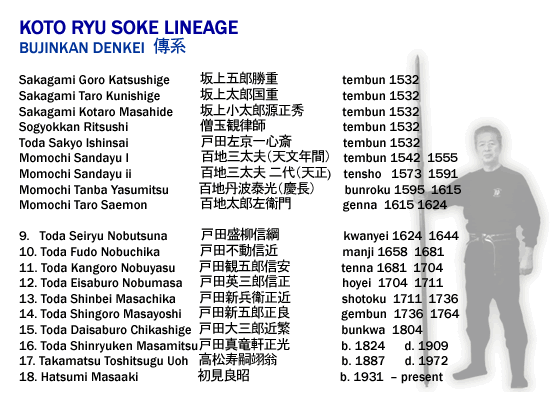
Koto Ryu
History of Koto RyuIt is thought that the Koto Ryu came from China via Korea, brought by Chan Busho, a Chinese warrior. You will notice that the first listed Soke’s of Koto Ryu are also the Sokes of Gyokkyo Ryu. There are many similarities between the 2 schools.
Some of the differences between
Koto Ryu and Gyokko ryu are as follows:
The Koto Ryu is based on koppojutsu (bone attacking blocks) techniques, where Gyokko Ryu is based on koshijutsu (muscle/organ attacks). Directionally speaking the Koto Ryu is straighter in and the Gyokko Ryu revolves more on a circular basis (either in yourself or in your opponent when taking their balance).
The Koto Ryu techniques use short distancing between the two opponents, the Gyokko Ryu uses greater distance. The Koto Ryu techniques are shorter, quick, and straight to the point; the Gyokko Ryu has longer more complicated techniques, and the techniques have more movement. The Koto Ryu concentrates more on striking, and the Gyokko Ryu more on locks and throws. If both schools are studied completely, the student will know all forms of fighting, including distance, striking, throws, and locks. Both schools compliment each other and to study only one is to know only half of one of the two schools.
The name of the school, ‘Tiger Knocking Down’, refers to knocking down the tiger with the tips of the fingers (the Chuden Kata techniques sometimes start this way).
Attacks to the face, in addition to metsubushi, are common in the techniques of the school.
The Koto Ryu is broken down into five levels which are as follows:
- KURAI DORI (Five Kamae)
- SHODEN NO KATA (Eighteen Techniques)
- CHUDEN NO KATA (Twelve Techniques)
- OKUDEN NO KATA (Twelve Techniques)
Okuden, and Hekito are the highest levels of training with the school, and contain the secret teachings. The Hekito is unarmed combat against sword, but a skilled member of the school can also do the Hekito with sword against sword.
The Bujinkan Dojo video Koto Ryu Koppojutsu by Soke Hatsumi shows three makimono (scrolls). Two of them have the name of the scroll partially clear and listed as such.:
- Koto Ryu Koppojutsu
- Koppojutsu
The rest is unclear.
Typical movement within the Koto Ryu is:
Yoko Aruki (cross stepping), and Toki (stamping on toes).
Short distancing, and striking hard.
A saying in the Koto Ryu is, “The eyes are everything”.
Always making the eyes appear blank, so that no telepathic movement can be detected by the opponent
Looking at the eyebrows of the opponent rather than their eyes.
The Koto Ryu has a unique form of Kenjutsu (Swordsmanship).
The Koto Ryu also contains kuji prayer forms and they are called Sanpo Gassho (3 treasures). These same kuji also appear in the Gyokko Ryu. They are listed as the Gassho Kuji Kiri (nine symbol slashes prayers).
“Sanpo Gassho”
- Kongo – Cloud prayer
- Suirin – Water ring prayer
- Kaku Gassho – Fire and winds prayer
